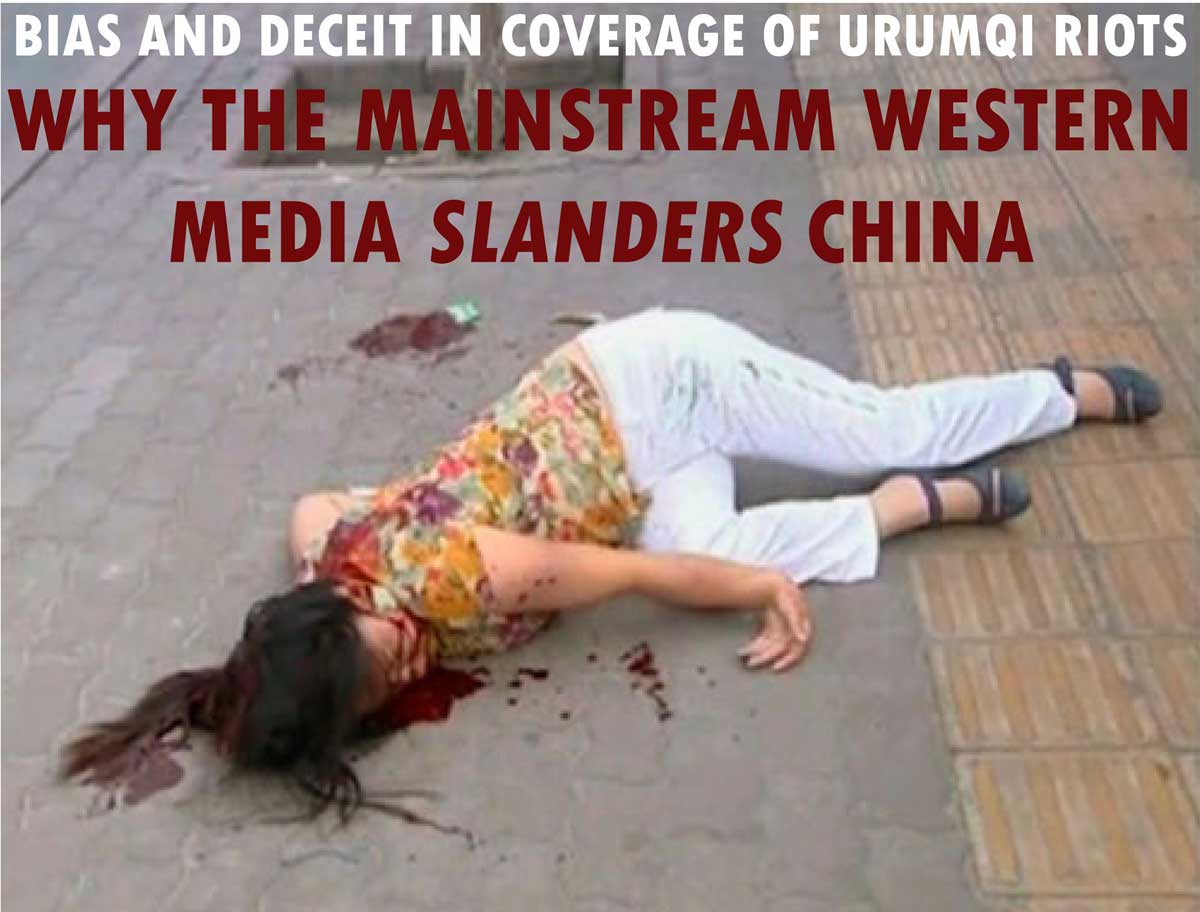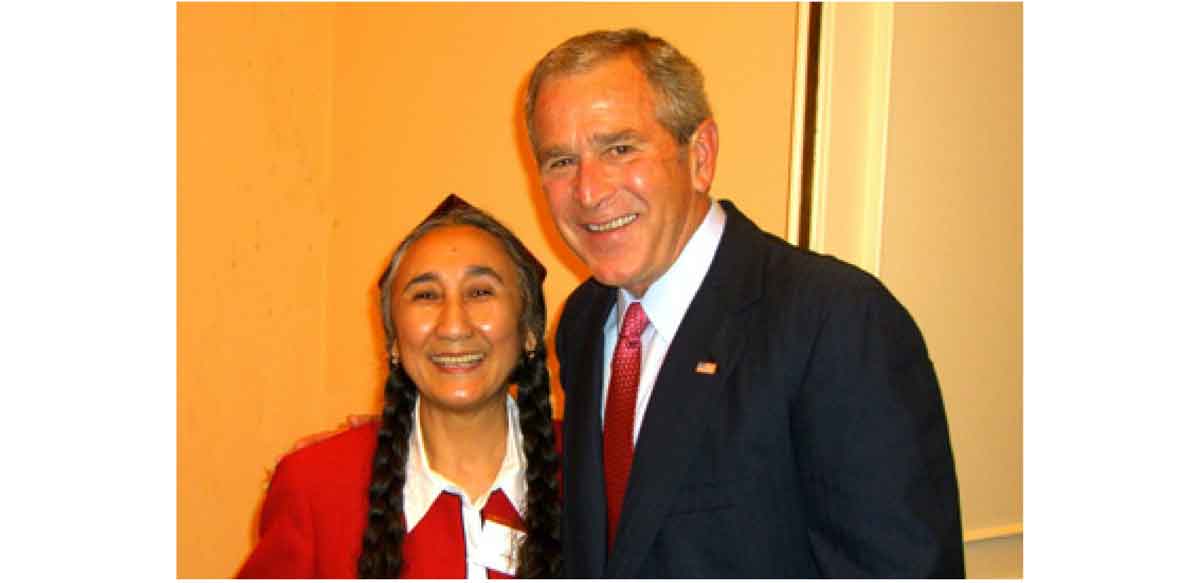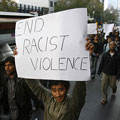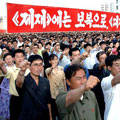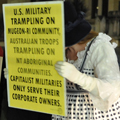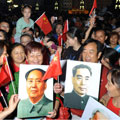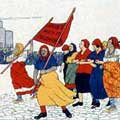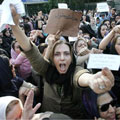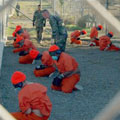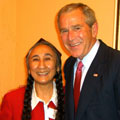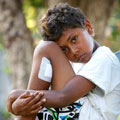Han Chinese women murdered by right-wing rioters. Australian media refused to challenge lies by Australian-based Uyghur anti-communists that Chinese media had failed to produce any photographs of dead Han Chinese people.
When millionaire Australian executive, Stern Hu, was arrested in China for bribery and stealing state secrets the mainstream Australian media churned out anti-China propaganda on overdrive. The media did not even leave open the possibility that the Rio Tinto boss was actually guilty. Instead, they speculated that he was either detained to teach Rio Tinto a lesson for refusing to accept the investment offer of Chinese state-owned Chinalco or was arrested to intimidate Rio Tinto and BHP into accepting China’s calls for lower iron ore prices. The Rupert Murdoch-owned
The Australian newspaper led the charge against the Peoples Republic of China (PRC). A 23 July article was headlined, “Don’t Kowtow to Beijing bully” and declared: “Only a fool could imagine that Hu’s arrest was anything other than a complete political set-up.” An earlier July 13 article by
The Australian’s foreign editor insisted that, “It is important, analytically, not to get caught up in the proceduralism of the Chinese legal system. There is no rule of law in China.” Or rather, the Western media has no interest in the facts!
Such press coverage about the PRC is hardly new. The Western mainstream media’s hostility to the Chinese state goes back a long time. It goes back almost 60 years – to the time that Mao Tse Tung’s Communist Party achieved political power in China. That was the moment that the Western media started crusading against Beijing. In the last year and a half, the media drive against the PRC has again gone up another gear. The Western press feared that a successfully hosted Olympic Games in Beijing would give socialistic China more international sympathy. So they sought to tarnish the PRC in the lead up to the Games. As a coalition of anti-communists, from hardcore right-wingers to ignorant small-l liberals, mobilized to sabotage the Beijing Olympics torch relays in Western cities, the mainstream media did everything possible to encourage these anti-communist protests. Then, when at the 24 April 2008 Canberra leg of the torch relay, the anti-PRC lot were numerically overwhelmed by Chinese students carrying the pro-communist, red PRC flag, the Western media screamed like sore losers. They ludicrously claimed that the international students who were so vibrantly and passionately participating in the pro-PRC demonstration were forced to attend the rally by the Chinese Embassy. The 2008 ANZAC Day edition of The Australian cried that, “Beijing suppressed freedom of expression in the heart of our democracy.”
The month prior to this Olympic torch relay leg, the Australian, American and European media had bombarded their home populations with distorted reports about the Tibet issue following right-wing riots in the PRC’s Tibetan Autonomous Region. These riots had been unleashed by supporters of the Western-backed Dalai Lama. Although the pro-Dalai forces clothed themselves in the robes of Tibetan separatism, their primary purpose was not so much to set up an independent Tibet but to create a Tibet independent of Communist Party rule. The anti-communist rioters represent the interests of the unrepentant families of the former feudal ruling elite of Tibet who long for the previous Dalai Lama-ruled days - days when they had the mass of brutally oppressed slaves and serfs toiling for them and answering to their every whim. They hate the Chinese communists for liberating the serfs and slaves and hate even more the former Tibetan serfs and slaves who now dominate the provincial government of the Tibetan Autonomous Region. The March 2008 riots saw the anti-PRC forces rampaging through the streets of the Tibetan capital, Lhasa, burning and hacking to death 18 civilians. They especially targeted non-Tibetan people - people who make up just small minorities in the Tibetan Autonomous Region. The pro-Dalai Lama mobs, for example, burnt down the Grand Mosque of Tibet that is frequented by the Hui Muslim minority. In response to all these attacks, the PRC security forces quite naturally mobilized to protect the population and stop the violent anti-communist forces. However, the Western media skillfully combined reports of the deaths in Tibet and news of the PRC security crackdown to give the false impression that the deaths were caused by the PRC police and military. In addition to such deceptions, the mainstream media also parroted as fact statements from the Dalai Lama - that were later proved to be complete lies - that the PRC forces had opened fire and killed large numbers of Tibetans.
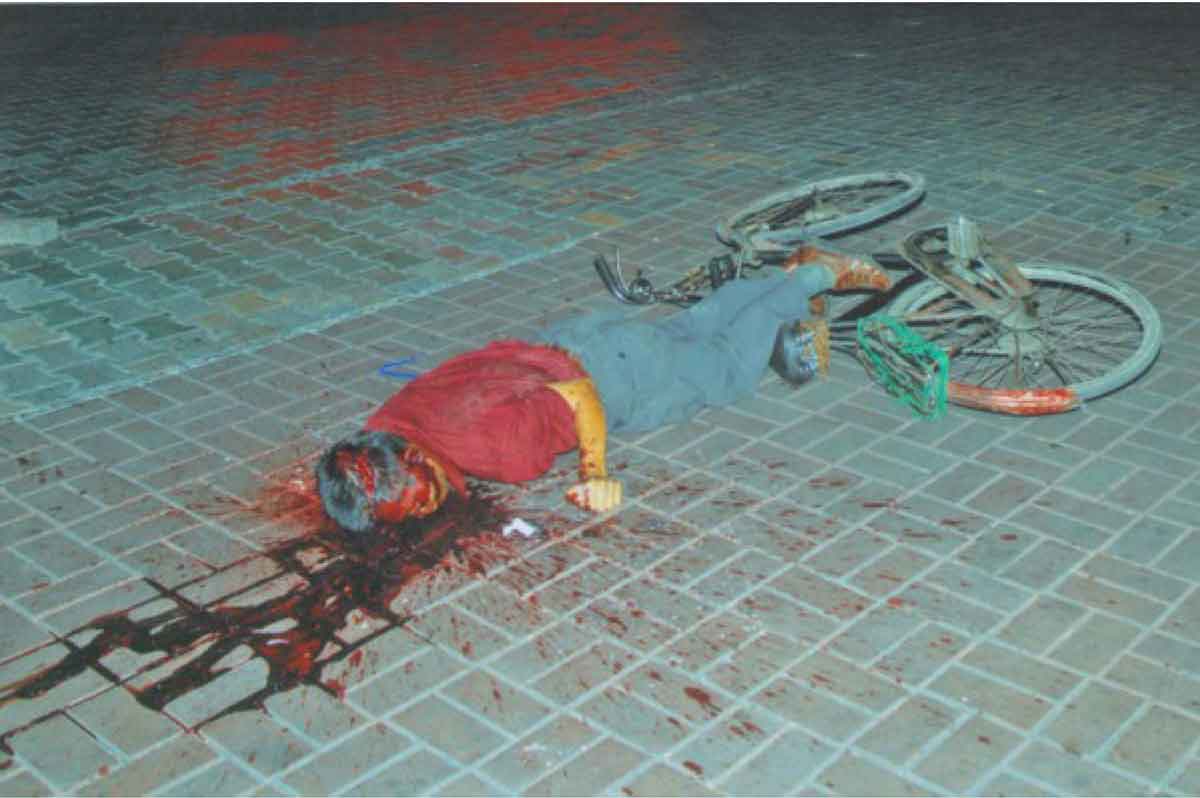
Urumqi, July 2009: Man butchered by right-wing, anti-PRC rioters in China’s Xinjiang-Uyghur Autonomous Region. Anti-communist rioters acted under the guise of Uyghur separatism.
When similar but even more lethal right-wing riots took place in Urumqi (the capital of China’s Xinjiang Uyghur Autonomous Region) last July, the Western media again deceitfully sought to create the impression that most of the killings were caused by the PRC security forces. In fact, the overwhelming majority of the 197 people killed in the turmoil in Urumqi were innocent civilians murdered by hard line anti-communists within the ethnic Uyghur community on the night of July 5. The anti-PRC mobs in particular targeted non-Uyghur minorities within the Autonomous Region as well as those Uygurs with minority friends. Of the 156 dead people who have been identified as innocent civilians (29 victims were yet to be identified at the time of writing) 134 were Han – the majority community in China but a minority in the Autonomous Region – 11 were from the Muslim Hui minority and one was from the Man group.
In response to the July 5 killings, some enraged Han people responded with racial violence of their own. These Han chauvinist mobs attacked Uyghur people. Ten Uyghur people are among the civilian dead (it is not known how many of them were killed by the rightwing Uyghur mobs and how many by the Han chauvinists.) In such a situation of bloody inter-ethnic violence, the PRC authorities had no choice but to crack down on the murdering mobs. Although the Chinese police were slow to deal with the initial riot, they eventually mobilized in the required big numbers and responded appropriately. PRC police came down hard against the Han vigilante mobs and dispersed many of them with tear gas. In the course of stopping ethnic-based murder attempts on both sides taking place before their eyes, the PRC security forces shot dead twelve of the people committing violent attacks. However, the Western media did its best to make their audience believe that most of the 197 people killed in the riots were merely peaceful protesters mowed down by Chinese security forces.
The Australian Media and Rebiya Kadeer
The July 5 riot was instigated by an organisation that calls itself the World Uyghur Congress (WUC). This group is headed by a U.S.-based, multi-millionaire capitalist, Rebiya Kadeer. Kadeer’s son, daughter and brother who still live in the Autonomous region were so ashamed about what she did that they wrote an open letter apologizing to July 5 riot victim families. In the letter they expose how their mother and sister, Rebiya Kadeer, not only incited the violence but from the distance of the U.S. had advance warning of it, indicating her role in its direct planning:
“After an incident between Uyghur and Han workers of a factory in Shaoguan of southern Guangdong Province broke out on June 26, she [Kadeer] exaggerated the facts and distorted the truth on the Internet, raising the death toll from two to more than 50, and posted counterfeit pictures, which triggered the riot….
“Six hours before the riot happened on July 5, we received a phone call from our mother (sister) Rebiya Kadeer, warning us there would be a `big incident.’ We are very angry and ashamed after the riot happened.”
Rebiya Kadeer grew up in the Xinjiang Uyghur Autonomous Region of the PRC. She became an extremely rich capitalist exploiter. In fact, Kadeer became the richest woman in all of China. However, in socialistic China - even following the post-1978 reforms that allowed a degree of capitalism - the right to capitalist exploitation of labour is not guaranteed and many capitalists come under strong pressure to give more back to society. Kadeer no doubt felt this pressure – her company would later be exposed for tax evasion – and responded by going into opposition to the PRC workers state. She went openly over to supporting the U.S. imperialist drive to restore capitalist rule in China. Like several other capitalist exploiters, and would be exploiters, who long for the pre-PRC times of capitalist rule, she masks her agenda under the cloak of ethnic nationalism. In her case it is Uyghur nationalism. Unfortunately, the WUC have been able to manipulate legitimate economic grievances amongst the Uyghur people. Although the PRC’s public-sector dominated economy has overall brought great economic benefit to its ethnic minority regions, China’s post-1978 market reforms have caused inequalities between rich and poor, economic rivalries and unemployment that have all hurt some Uyghur people, among others.
Given the true agenda of Rebiya Kadeer and the WUC it is little wonder that they are heavily backed and even organized by the American capitalist ruling class. It was Washington that pressured China to allow Rebiya Kadeer to go into exile in the U.S. in 2005. In a 2007 speech in Prague on “Freedom” where he hailed the destruction of the Soviet Union and East European socialistic states, George W. Bush heaped gushing praise on Kadeer: “The talent of men and women like Rebiyah is the greatest resource of their nations, far more valuable than the weapons of their army or their oil under the ground” (Text released by Office of the Press Secretary of the White House, 5 June 2007). Tellingly, in the same speech, Bush also hailed noted counterrevolutionary “dissidents” in Cuba and Vietnam.
Today, the U.S. government continues to back Kadeer through the U.S. Congress-directed National Endowment for Democracy (NED). The NED helps to orchestrate the WUC’s work. In a May 11 press release, the Uyghur American Association on behalf of the WUC announced that “the WUC, in conjunction with the National Endowment for Democracy (NED)” would host “a seminal human rights conference focused on East Turkestan entitled East Turkestan: 60 Years under Communist Chinese Rule, from Monday, May 18 to Tuesday, May 19” (Third General Assembly of the World Uyghur Congress to be held in Washington, DC, UHRP website). Established by the U.S. Congress in 1983 and largely funded by it, the main work of the NED has been to create and bankroll anti-communist movements around the world. Today, the NED is well known for backing counterrevolutionary forces in Cuba and right-wing opponents of Hugo Chavez in Venezuela.
The NED’s methods are to assist the outfits it backs to spread their propaganda, bribe influential figures and manipulate the media. The NED has certainly taught the WUC well the CIA’s notorious “disinformation” tactics. A key trigger for the July 5 riot was indeed such a “disinformation” posting on an international Uyghur internet group by a WUC leader in Germany. The posting showed a video of what he said was “a Uyghur girl beaten to death” and then called for Uyghur people to “repay blood with blood.” It turned out that the video showing a girl in red being beaten to death by a group of people using stones was originally broadcast by CNN in May 2007 as something that happened in the Mosul city of Iraq on 7 April 2007!!! Later, Kadeer in an interview with Al Jazeera showed a photo of what she claimed were “peaceful Uyghur protesters” in Urumqi and how they were treated by Chinese police. The photo was later found to be cropped from a Chinese news website image of a completely unrelated June 26 protest in Shishou, Hebei Province!!!
Mutual Admiration Society
June 2007: George Bush with Uyghur anti-communist Rebiya Kadeer at a conference on “democracy” and “security” in Prague. In his conference speech Bush hailed Kadeer along with similar counterrevolutionary “dissidents” from Cuba and Vietnam.
The National Endowment for Democracy not only guides the World Uyghur Congress but also directly funds it. And how can we be sure of this? Well, it slipped out of the horse’s mouth! At a U.S. State Department Daily Press Briefing in Washington on July 13, Department Spokesman Ian Kelly, in response to a question about China asking the U.S. to stop funding to Kadeer’s organization admitted that:
“ her [Rebiya Kadeer’s] organization does receive funds from the National Endowment of Democracy, which is [sic] – receives its funds from Congress.”
- under “U.S. Relations with the PRC” in website of the Consulate General of the United States, Hong Kong and Macau
Yet the strong U.S. backing for Rebiya Kadeer and the WUC barely gets a mention in the mainstream Australian media. Australian editors seem to fear that the truth that Kadeer is a multimillionaire capitalist funded by the U.S. empire upsets the portrayal they wish to paint of her as a brave, “little” person who is standing up against all odds to a fierce dragon. Indeed, the Australian press is doing everything in their power to lionise Kadeer and the WUC. For starters, they always credit Rebiya Kadeer as being not a “Uyghur anti-communist leader” or even a “Uyghur separatist leader” but as “Uyghur leader” full stop - as if most Uyghur people in China support her. An August 5 The Sydney Morning Herald article on Kadeer even begins with the words, “The unofficial leader of the Uighurs, Rebiya Kadeer …” (emphasis added). Such characterizations deliberately ignore the ethnic Uyghur leaders who head the provincial government of the Xinjiang Uyghur Autonomous Region – people like Nur Bekri who is chairman of the Autonomous Region’s government. It also ignores the ethnic Uyghurs who are national political leaders in the PRC, like current vice chairman of the Chinese People’s Political Consultative Conference, Abdul’ahat Abdulrixit. But, alas, they are all on the opposite side to Kadeer and her imperialist backers - they are Communist Party members. So the media here prevents the Australian population from even knowing that such Uyghur leaders exist.
Another way that the Australian media promotes the anti-Peoples Republic of China forces is by extensively quoting from them and generously airing their views. To be sure, the media does give small snippets of statements from pro-PRC representatives too. This, indeed, is what makes the Western “free” media so effective in imposing its biased point of view. They seek the credibility of being “even-handed,” by “including all points of view.” Only that the side they support always gets ten times more air-play or column space than the side they oppose!
It is not only the quantity of quotes from the different sides that the Western media forwards on but also the contrasting ways in which the statements from the different sides are introduced that is crucial here. So even when The Sydney Morning Herald reported that Kadeer’s family had written letters condemning her for inciting the Urumqi riot, it was in an article headlined: “‘Fake’ letters blame Kadeer over Urumqi” (The Sydney Morning Herald website, August 3 posting). Although the word ‘Fake’ is here in quotation marks its very inclusion in the headline immediately prejudices readers against the letter. Then in the August 5 issue of The Sydney Morning Herald, quotes from Kadeer that the letter “is a forgery, transparent propaganda” are followed by the journalist stating in her own words that, “she [Kadeer] is resigned to the fact that China might well have coerced her family into signing such letters.” In other words, the newspaper has presented the reader with just two options about the letters - they are a forgery or Kadeer’s family were forced into signing them. The possibility that the letters are genuine is effectively excluded. In contrast when Rebiya Kadeer’s statements are referred to they often get the sanction of the journalist. So, later in the same August 5 article referred to above, the article states that “she [Kadeer] wants Australians to know that although her people are being jailed and killed in China, she disavows terrorism.” Here “her people are being jailed and killed in China” is presented as a fact. Her statement is not reported as, “she wants Australians to know that although, as she claims, her people are being jailed …” - no only the “disavows terrorism” part of the sentence is presented as being an opinion open to question, the rest is given the status of a fact. Similarly, in the 18 July Sydney Morning Herald article publicizing Kadeer, the article’s first sentence states that “… Rebiya Kadeer will use a visit to Australia next month to urge the Government to take a stand over China’s violent repression of demonstrations in her homeland ….” Again it is carefully written to avoid saying: “take a stand over, what she says are, China’s violent repression of demonstrations in her homeland.” No, “China’s violent repression of demonstrations in her homeland” is presented by The Sydney Morning Herald as an undisputable truth.
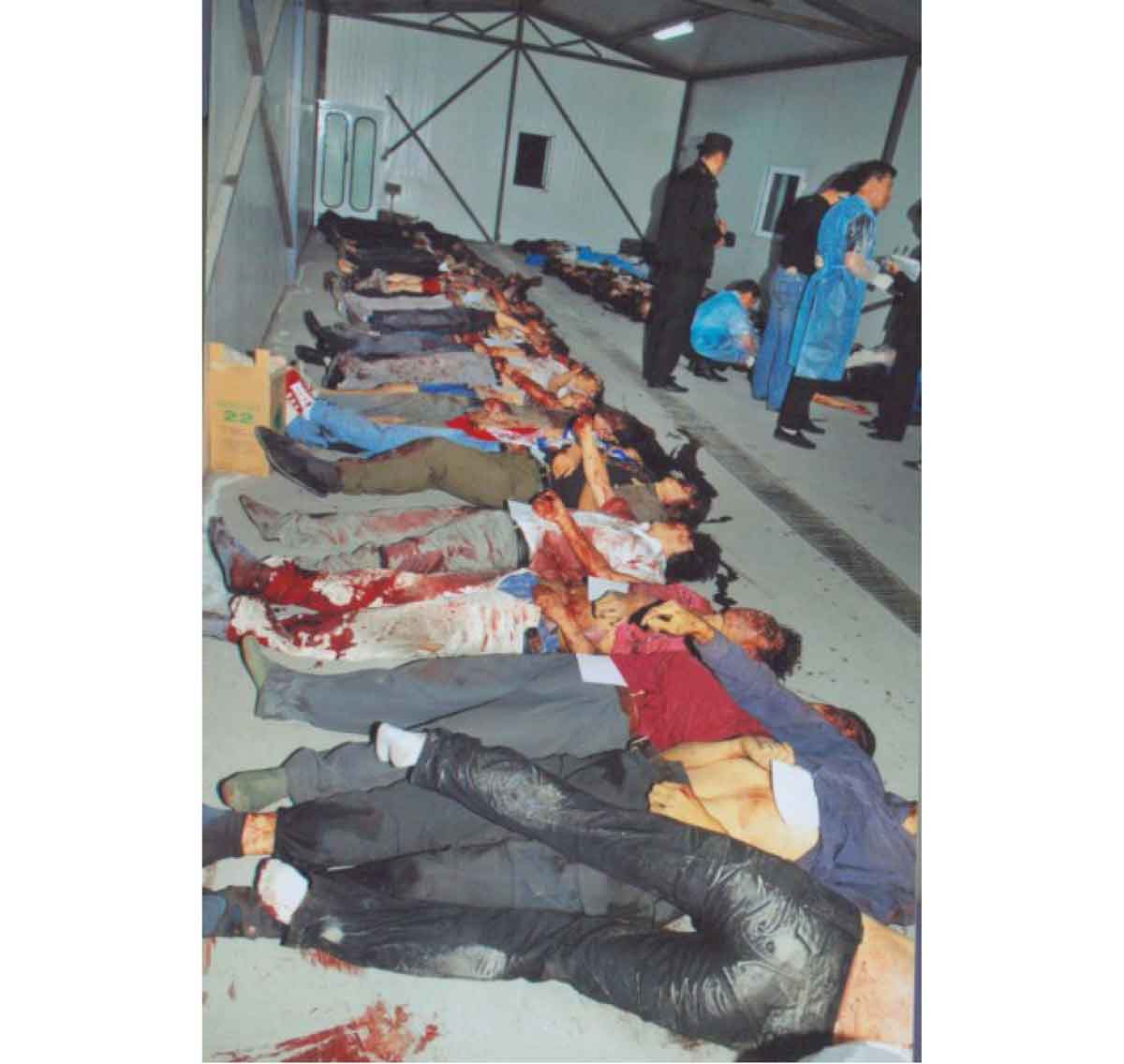
Urumqi: Dead bodies of mostly Han Chinese people killed by racist mob.
U.S-backed anti-communists massacred civilians with horrifying brutality. Mainstream Australian media almost completely censored such images showing the brutality of the pro-Western forces.
The Sydney Morning Herald: A Case Study in Misleading Reporting
Indeed, by examining
The Sydney Morning Herald coverage we can get a good overview of the “objectivity” of the whole Australian press in its coverage of the Urumqi violence. After all, Fairfax Media’s
Sydney Morning Herald is relatively more liberal than the Rupert Murdoch-owned papers. So, if
The Sydney Morning Herald has a strong anti-PRC bias then we can be confident that the crusading anti-PRC rightists in
The Daily Telegraph,
Herald Sun and
The Australian will be at least equally as bad. Let us not forget that in Australia just about every major newspaper is owned by one of these two filthy rich companies – Murdoch’s News Corporation and Fairfax.
Typical of The Sydney Morning Herald reporting of the Urumqi events is their July 8 article on the issue. Reporting the official death toll of 156 people killed in the violence, the article is titled “Crowd vents fury at police after bloodshed.” Now, that headline is designed so that readers will at once assume that the crowd is “venting fury at the police” because the police committed the killings. In fact, however, the “crowd venting fury at the police” are not relatives of dead victims but wives and mothers of those who have been arrested for allegedly committing the bloodshed. According to the article, the crowd demanded “the release of their sons and husbands, who they said had been beaten by police and taken to unknown destinations.” This demonstration by relatives of alleged pogromists seems to have been put on for the benefit of the Western media and some TV reports seem to reveal that a few Western reporters are even coordinating their actions with the anti-PRC forces. Regardless, even the anti-PRC demonstrators who were themselves reported in this Sydney Morning Herald article were not claiming that their sons and husbands had been shot in the streets by the Chinese security forces or that their sons and husbands were among the over 150 people killed in the Urumqi events. Yet that is what the article headline strongly implies.
To be sure, in this particular article The Sydney Morning Herald is too clever to actually state in as many words that the PRC police committed the bloodshed in Urumqi. The Western “free press” must maintain their image of “objectivity” by avoiding telling too frequently such bald-faced lies. Instead, however, the article does everything possible by stealth to lead the readers to this false conclusion. First there is the deceptive headline. Then there are a series of “unconfirmed rumours” of PRC police killing Uyghurs that are reported here. The article, for example, states that, “one Uyghur onlooker told the Herald he had seen police shooting protesters on Sunday night – he said hundreds had been killed – but the Herald had been unable to verify any of the claims.” Although such completely baseless claims are reported as “unverified” their mere inclusion in the article helps to give credence to the original misleading headline. Of course, the article never queries why there has been no demonstration by relatives of Uyghurs that “unconfirmed rumours” have claimed were cold-bloodedly shot by the security forces - only demonstrations by relatives of those arrested for participation in the deadly riots. Meanwhile, there is never any reporting in the article, even as an “unverified claim” of the killing of about 150 innocent people by the anti-communist mobs. The closest the piece gets is a statement by a man about how he was beaten by Uyghurs. There is not even a reference to the dead bodies of Han and Hui people killed by rioters shown on Chinese state media – no, this is not included in any way in the article, not even as a “claim that could not be verified.” Thus, any reasonable reader who is uninformed of the actual events has little opportunity to draw any conclusion other than the deceitful one promoted by the headline: that the PRC police committed most of the killings in Urumqi. What masters of “democratic”, “even handedness” are the editors of The Sydney Morning Herald!
Following their deceptive coverage of the actual Urumqi riots, The Sydney Morning Herald then turned to promoting Rebiya Kadeer. The newspaper echoed all the claims of Kadeer and her ilk about alleged discrimination of Uyghurs with almost no reporting of the opinion on this subject of the Beijing government or of the pro-PRC Uyghurs that run the Xinjiang Uyghur Autonomous Region government. I guess this is what is called the “balanced journalism” of the “free press.” One Sydney Morning Herald article (18 July) reports that “Uyghurs [actually only Uyghurs that support the likes of Kadeer] say China is committing a form of ‘cultural genocide’ by banning the teaching of Uyghur language in schools, discriminating against Uyghurs in jobs, closing mosques and even demolishing ancient Uyghur cities ….” Not only does The Sydney Morning Herald fail to present the viewpoint of the many Uyghur leaders in the Xinjiang Uyghur Autonomous Region who disagree with these claims but they make no effort to verify these claims themselves. They make no effort because if they did they would have to report that each of the claims is false. Most ridiculous is the assertion that the PRC has “banned the teaching of Uyghur language in schools.” In fact, not only do Uyghurs in the Autonomous Region learn their own language in the state schools but they are so much educated in their own language that most cannot speak the national language, Mandarin, fluently (this lack of bilingualism is actually a problem that if not overcome will cause disadvantage). Indeed, Kadeer is herself a walking refutation of the lie that Uyghurs have been cut off from their own language. She grew up and went to school in the PRC and yet can only speak fluently the Uyghur language and not Mandarin – which, by the way, did not seem to stop her from becoming China’s richest woman. Notably, too, despite claims broadcast by the Australian media from anti-communist Uyghur groups that Uyghurs are subject to special oppression under China’s “one-child” policy, Kadeer herself had eleven children while living in the PRC! Of course, the “independent” Sydney Morning Herald was not about to expose any of these contradictions.
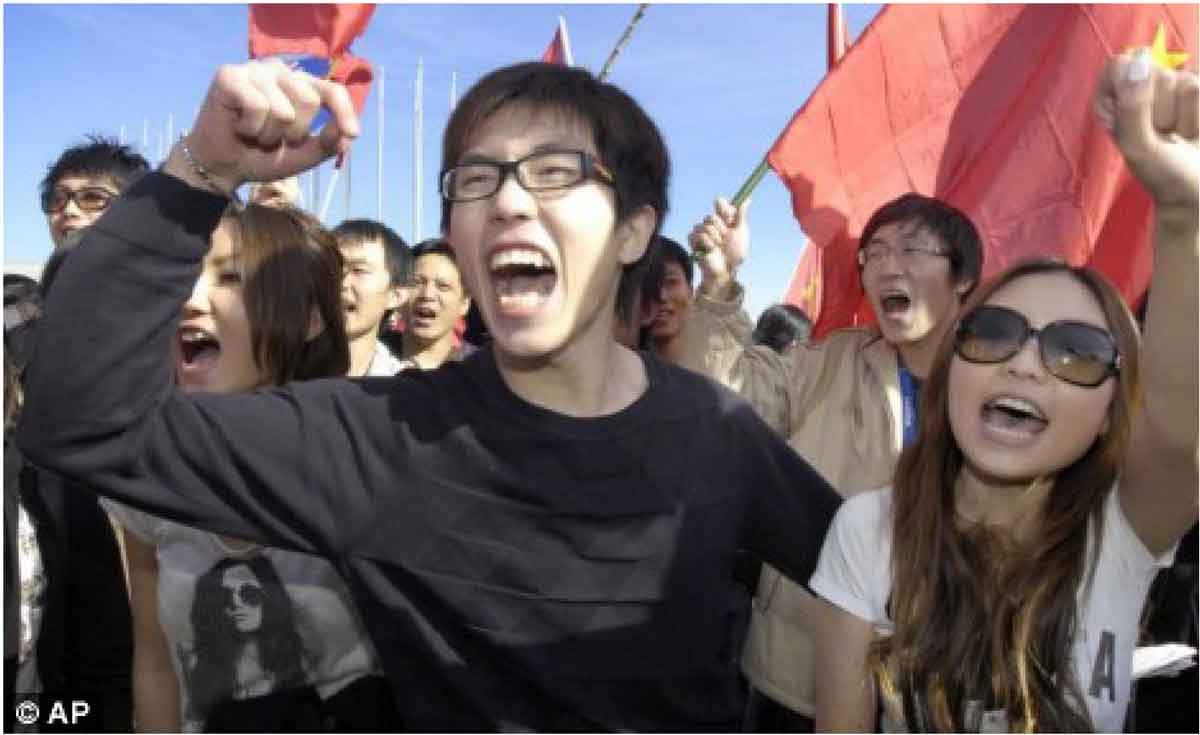
Spirited: Tens of thousands of Chinese people rallied to support the PRC during the Canberra leg of the Beijing Olympics Torch Relay. This powerful support for the PRC – mostly by international students who have experienced life in both China and Australia – enraged Australian capitalist media. Media went to great lengths to vilify the pro-PRC protest.
“Protesters” and “Terrorists”
The crescendo of media voices promoting Kadeer reached a peak as she was arriving in Australia to attend the August 8 premiere of a film backing her agenda. The film,
The 10 Conditions of Love, was premiered at the Israeli government-sponsored Melbourne International Film Festival. The media symphony that accompanied Kadeer’s entrance was that the Communist Party government in China was oppressing the Muslim Uyghur minority. Ironically, however, on the very day that Kadeer arrived in Australia, August 4, Australian police were raiding Muslim Somali and Lebanese migrants in Melbourne. Those targeted in the massive raid were accused of planning a military attack on the Holsworthy army base in Sydney. The reaction of
The Sydney Morning Herald and the rest of the Australian media to the Muslims arrested in Melbourne could not be more different to their attitude to the Uyghur Muslim rioters arrested by Chinese police in Urumqi. Those arrested in Urumqi for violently attacking civilians were sympathetically portrayed by the media as innocent “protesters.” In contrast, the Somali and Lebanese migrants raided here were automatically branded as “terrorists.” “400 police mount counter-terrorism raids” headlined
The Sydney Morning Herald (website, August 4) in announcing the massive police mobilisation. The next day they headlined, “Australia foils Somali-linked Islamist attack” declaring that police had foiled “what would have been the country’s worst extremist attack.” Yet, unlike the anti-communist WUC-backed forces in Xinjiang, those arrested here never killed any civilians nor did they have any plans to. They are only
alleged to have targeted an Australian military facility.
The Australian Muslims alleged to have been targeting Holsworthy were motivated by justified revulsion at the Australian military’s role in the brutal occupations of Iraq and Afghanistan. In contrast to China’s People’s Liberation Army (PLA) which serves the interests of the Chinese masses (albeit in a bureaucratically deformed way) the Australian military does not in practice defend the interests of the Australian masses but only the interests of Australia’s rich capitalist class. Thus, in contrast to the PLA, the Australian military not only participates in the murderous U.S/NATO war in Afghanistan but also enforces imperialist exploitation of East Timor and the Solomon Islands. Those alleged plotters against the Holsworthy military base may have been driven by a terribly warped, religious fundamentalist ideology. Their allegedly chosen methods may have been ineffective. But anyone who opposes the Australian military is objectively standing against imperialism. This is unlike the anti-communist, pro-WUC forces in Xinjiang who are not only funded by America’s National Endowment for Democracy but are serving the imperialist goal of undermining the PRC socialistic state. Thus the Australian workers movement ought to, on the one hand, oppose the anti-communist Uyghur rioters and, on the other hand, defend against state repression those Muslims arrested in the recent Melbourne raids. In other words, the Australian working class ought to take a position on these two questions that is the diametric opposite of that taken by the mainstream Australian media.
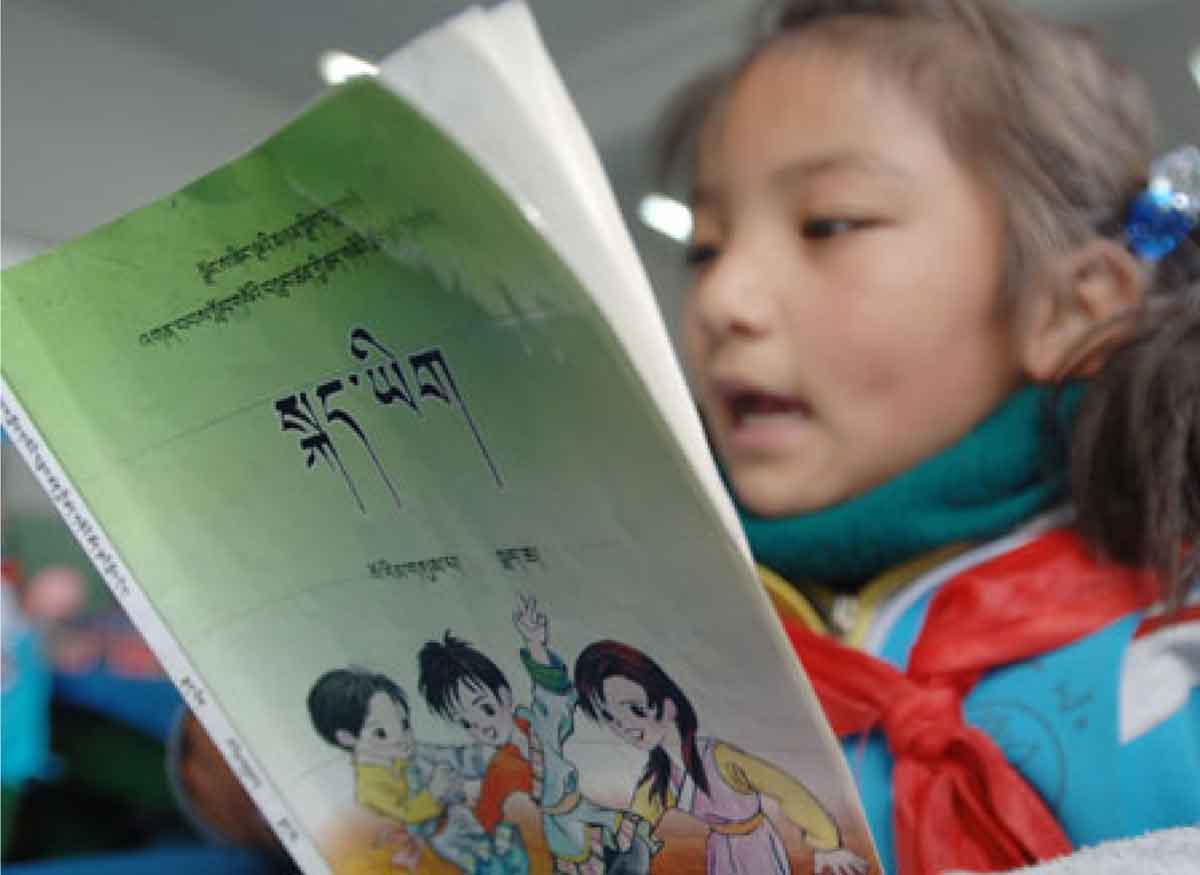
Lhasa, capital of the PRC’s Tibet Autonomous Region: Tibetan girl Dainzin attends Tibetan language class at No. 1 Primary School. Contrary to Western media insinuations, ethnic minorities in the PRC, including Tibetans and Uyghurs, learn their own languages in state schools. The advent of socialistic rule has brought tremendous growth in the number of people literate in Tibetan, Uyghur and other minority languages in China.
One of the Melbourne Muslim people arrested in the August 4 raid courageously defended himself when he faced court the next day. Wissam Mahmoud Fattal pointed out to the Melbourne Magistrates Court that it was the Australian troops that killed innocent people overseas. “You call me a terrorist but I’ve never killed anyone in my life,” Fattal stated, “You send troops to Iraq to kill innocent people.” Quite right! Yet there was no sympathy for Fattal from the Australian media – the same media that made excuses for those that butchered innocent Han and Hui people in Urumqi. Nor was there any acknowledgement of the social conditions faced by African immigrants that would drive them into opposition to the Australian political order – such as bullying and bashings at the hands of racist cops, high unemployment and discrimination in housing. Unlike many of the PRC’s ethnic minorities (like the Uyghurs) who – quite rightly since it is necessary to correct the terrible discrimination they faced in pre-1949 capitalist China – are granted special rights such as exemption from the one-child policy, African migrants in Australia face official discrimination such as refusal by state bodies to recognize their overseas qualifications. Many highly educated African migrants now try to get by driving taxis after having become sick of their job applications repeatedly being knocked back on account of their ethnic names or, if they are ever lucky enough to get to an interview, on account of their black face. This bitter experience shapes people throughout African communities in Australia, including those who are unlucky enough to be less well educated. However, the Australian mainstream media are about as likely to inform their readers about all this as they are to report that the PRC has an affirmative action policy that allows Uyghurs, and many other minority communities, university entrance with lower marks than are required for Han Chinese students.
So Back To: Why, Why, Why?
Yes, why is the mainstream media so hostile to the PRC? This is a question that has been greatly exercising the minds of pro-PRC, Chinese international students and migrants. One theory is that the Western media’s warped stance on issues like Tibet and Xinjiang are a product of simply being
ill-informed of the facts. Certainly, there are some reporters in the Australian media who are ignorant. However, this is far from the full story. Many Western journalists are all too knowledgeable and they use their knowledge to help them better impose a biased viewpoint upon their audience. Consider this: when the March 2008 riot took place in the Tibetan Autonomous Region, Beijing quite understandably imposed restrictions on Western media access to the region to stop them inflaming the situation. However, this lack of access gave the Western media just the excuse they needed to rely totally for “information” on the pronouncements of anti-communist Tibetan exile groups. The Western media simply broadcast the most far-fetched claims about a supposed PRC “brutal crackdown” in the Autonomous Region. So, when the Urumqi riots happened, Beijing tried a different policy. The Chinese government gave the Western media free access to Urumqi – access to a live domestic conflict zone which was somewhat unprecedented for any government to grant (certainly not the access the U.S. government gave the media when they stormed the Iraqi city of Falluja or Israel when it invaded Gaza). Beijing hoped that the now better informed Western media would give more accurate accounts than the ones they gave about Tibet last year. Instead, while the Western reporters were themselves now better informed, they used still more cunning methods to deceive their audience and mislead them as to what the real truth was. You see, a lack of knowledge of the facts is not the underlying problem here!
Then what is? Many think it is the racism in the Western countries that shapes its media’s hostility to the PRC. That certainly is a factor, especially in Australia, which for decades last century even had a White Australia Policy formally excluding non-white people such as the Chinese from entering the country. However, if racism were the only factor then it cannot explain why the Australian media has a rather sympathetic attitude to other Asian countries. For example, the media here covers up for the murderous repression by the capitalist Philippines government. In the last few years, the Philippines security forces and right-wing death squads have assassinated literally hundreds of trade unionists, peasant activists and leftist student organizers. But how much coverage does that get in the Australian media? And how much do the Western media report about the frequent arrests of striking workers in capitalist South Korea? In one day alone on May 16 in the city of Daejon, South Korean police arrested over 450 trade unionists. Did that make headlines on Channel Nine or even SBS World News?
Some people have suggested that China is particularly the target of racism in the West because it is becoming a world power and the patronizing Western media cannot stomach the rise of a non-white country. True enough. However, if that were the only reason that the American, European and Australian media slanders the PRC then why are they not also attacking the other non-white world powers. For example, the mainstream media in Australia and America are favourable towards Japan – this despite the fact that both countries fought a major war against Japan. And although there is plenty of anti-Indian racism in the Australian media, the Indian political regime generally gets a positive depiction. When in 2002, racist mobs from India’s majority Hindu community went on a rampage in Gujarat province and murdered up to 2,000 Muslim people, the Western media not only did not give much prominence to the riots but did not try to use the events to attack the Indian political establishment. This is despite the fact that, unlike in the Urumqi riots, the state authorities from India’s Gujarat province, criminally, actually encouraged the bloodletting.
So, clearly, being a non-white world power is not enough to make one a target of Western media hostility. A few Chinese people then speculate that there is a particular Western hostility to ethnic Chinese people. Yet Chinese-majority countries other than the PRC get sympathetic coverage from the Western media. Take Singapore. Then there is Taiwan. It is telling that Greg Sheridan, the hard core China-basher who is Foreign Affairs editor of
The Australian newspaper, just loves Taiwan. It is instructive also to look at the Western media coverage of Typhoon Morakot that hit both Taiwan and the PRC. Morakot killed hundreds of people in Taiwan but less than fifteen people in the PRC. The relatively low death toll in the PRC, despite immense material damage, was due to a massive state-organised evacuation there of nearly one million people. In contrast, in Taiwan, a heavy death toll occurred because the Taiwanese government was callously slow to rescue people stranded by the typhoon, many of whom are from Taiwan’s indigenous groups. Yet the Taiwanese regime’s negligence which has led to angry outcries by relatives of those who were stranded received little headline coverage in the Australian media. Nor has the Australian media pilloried Taiwan President Ma Ying-jeou for his crude statements blaming victims for not evacuating. In contrast, imagine how the media would have reacted if PRC president Hu Jintao had done a similar thing!
The different way in which the PRC and Taiwan – both majority ethnic Chinese entities - are portrayed goes right to heart of why the Western media hates the Peoples Republic of China. You see, Taiwan is ruled by a capitalist state and the PRC by a socialistic one. And this is the overwhelming reason why the mainstream Western media is hostile to the PRC while being sympathetic to Taiwan. In Australia, Europe and the U.S., all major media outlets are owned by either capitalist high-fliers or by capitalist governments. These capitalist owners ensure that their news outlets produce a line supportive of their class interests as capitalists. And that plainly means hostility to workers states like the PRC. Despite the incomplete, hesitant and precarious nature of the PRC’s transition to socialism, the billionaire media bosses understand that the existence of some form of workers power in the world’s most populous country is an obstacle to capitalist exploitation. Their hatred of the PRC and Cuba mirrors their hatred of militant trade unions at home, organizations which their media outlets also spare no effort in slandering.
Tycoons Call The Tune
The ownership of the Australian media is typical of the structure of media control throughout the capitalist world. As well as all the main newspapers being owned by either Murdoch or the Fairfax empire, we have the biggest TV network Channel 7, a whole lot of magazines and half of Yahoo7 being largely owned by tycoon Kerry Stokes and rich private equity investors under Kohlberg Kravis Roberts. Then we have Channel 9 (formerly owned by one of Australia’s richest men, James Packer) that is owned by the private equity high fliers in CVC Asia-Pacific. Meanwhile, James Packer, Rupert Murdoch and Kerry Stokes are all major owners of Foxtel alongside Telstra Corporation. Then there is ABC and SBS … which are both directly funded by the Australian capitalist state.
Defenders of the “capitalist democracy” ignore all this or when confronted with the truth about media ownership claim that it does not really matter because of “journalistic ethics” and the “strong traditions of press freedom and democracy in Australia.” However, back on planet Earth, it is he who pays the piper that calls the tune. This is why the Murdoch media outlets often produce a very similar political slant – a conservative, right-wing one - despite being spread across many countries from the U.S, to Britain to Asia to Australia. During the lead up to the onslaught against Iraq in 2003, all of the 175 newspapers owned by Rupert Murdoch around the world editorialized in favour of the invasion! And while the rich media moguls may not direct every single stance taken by the outlets that they own, their ownership of these media organisations ensures that the outlets always produce a bias favourable to their class interests as capitalists.
Rupert Murdoch, Kerry Stokes or J.B. Fairfax don’t have to call up their editors all the time for the “right line” to get through. They have already carefully hired the executives and managers who they know will choose editors that will push the kind of politics that they want. Being capitalist leaches on million dollar salary packages, the executives themselves have an interest in ensuring that their media outlet promotes capitalist rule. Therefore, the kind of editors and journalists that they hire are all going to be supporters of the capitalist system. A prospective journalist showing sympathy for the socialistic PRC at a job interview is certainly not going to get very far!
Meanwhile, when the tycoon owners have a strong opinion on a particular question, they can make clear their views through statements at board meetings or informally through quiet chats at company dinners and speeches at functions. The editors and journalists then know that it is best for them to “report” within these parameters set out by their ultimate boss if they are to get future promotions within the company. Those that are too independent and try push another line risk being squeezed out of their job. At best they would get sidelined into writing an occasional piece for, the less well read, opinion pages of the newspaper – articles that will, of course, always be buried amongst a whole lot of other pieces asserting the prescribed line.
Such is the nature of the “free press” in capitalist “democracies.” Yet, because of the credibility that they achieve as a result of their nominal independence from government and their formally “uncensored” status, the capitalist-owned media is all too effective at deceiving their audience. The nature of the “free” media in Western countries typifies the nature of “democracy” under capitalist rule: it looks like everyone is getting an equal voice but, actually, because the rich capitalists have most of the wealth and control key institutions, it is they who end up with the decisive say on all major issues. Let us note that even in the most nominally “democratic” of capitalist countries, the rich capitalists not only own the media but also control the other means of shaping public opinion – for example, the book publishing houses. Furthermore, the wealth of the rich elite allows them to be able to pay for political advertisements, finance brochures and leaflets and hire meeting rooms to a much greater degree than working class people. These capitalists are also disproportionately able to fund political parties, hire lobbyists and bribe (or should we say “gift”) politicians.
Through the rich ruling elite’s ability to shape public opinion and thus also the way people vote, the much vaunted “one person, one vote” of capitalist “democracies” becomes in practice more like “one dollar, one vote.” In any case, no matter which party is voted into office in capitalist “democracies,” the state that the governing party will administer is itself a machine whose every module - from its police, prisons and courts to its army, bureaucracy and spy agencies – is connected by a thousand wires to the capitalist elite. The uniform of the operator can change colours but the state machine remains pre-programmed to be always the capitalist’s machine. Thus, just as the “independent” media in capitalist “democracies” are subordinate to the capitalist tycoons that own the outlets, the capitalist “democracies” themselves are in reality only “democracies” for the rich.
Pro-Capitalist Agenda Versus Real Solutions
The capitalist media’s bias against the PRC reflects more than simply the tycoon’s emotional hatred for workers states. It is also a manifestation of something more sinister. It is part of a conscious effort by the Western ruling classes to promote capitalist counterrevolution in China. This they seek to do by, on the one hand, directly putting political pressure upon the PRC socialistic state and, on the other hand, by building support in their own countries for anti-communist Chinese exile groups (like Falun Gong, pro-Dalai Lama groups, World Uyghur Congress, various Chinese “pro-democracy” outfits etc). This agenda was particularly apparent in an August 12 article by foreign affairs editor of
The Australian, Greg Sheridan. Sheridan’s piece aimed to not only build support for Rebiya Kadeer but to direct her supporters on how they can best weaken the PRC. Sheridan advised Kadeer to leave aside her campaign for a separate state for a while and “concentrate instead on human rights, cultural autonomy and democracy” so as to win stronger support from Western leaders. The likes of Sheridan really have no genuine concern for the Uyghur people but only hope to make the anti-communist section of the Uyghur community a more powerful club with which to attack socialistic rule in the PRC. At one point in the article, Sheridan suggests that Kadeer (in the manner of the Dalai Lama) could push for a “one nation, two systems” set up in Xinjiang. This is a reference to the arrangement China currently has with Hong Kong, where Hong Kong is part of the PRC “one nation” but maintains a separate, i.e. capitalist, system. Sheridan hopes that by using the banner of “one nation, two systems” to re-establish the capitalist system in the likes of Xinjiang and Tibet, socialistic rule throughout the PRC will be corroded.
Now, the fact that the Western media spouts all those lies about the Urumqi riots does not mean that there are not real problems and ethnic tensions in the Xinjiang-Uyghur Autonomous Region and elsewhere in China. That the World Uyghur Congress and their ilk were able to mobilise people to commit the horrific atrocities on July 5 shows that there are grievances amongst the Uyghurs that they could exploit. Furthermore, the fact that a completely false rumour that ethnic Uyghur workers had raped two Han women could cause the massive June 26 brawl between local Han workers and Uyghur workers in a toy factory in Shaoguan city, Guangdong Province - a brawl that left two Uyghur workers dead - shows that while the ugly face of Han chauvinism may have been pushed back a lot since the pre-1949 days, it has not yet been fully eradicated. Until China’s transition to socialism is complete – and before this happens unemployment, poverty, financial insecurity and economic rivalry cannot be completely wiped out – ethnic chauvinism and resentments will to some extent still remain. What is needed to build ethnic unity in China is not a return to capitalist rule as the Western media wants but, in fact, the exact opposite. What is necessary is to intensify the drive towards socialism. This will be apparent if we look more closely at some of the social conditions that bred the ethnic tensions in Urumqi and Shaoguan city.
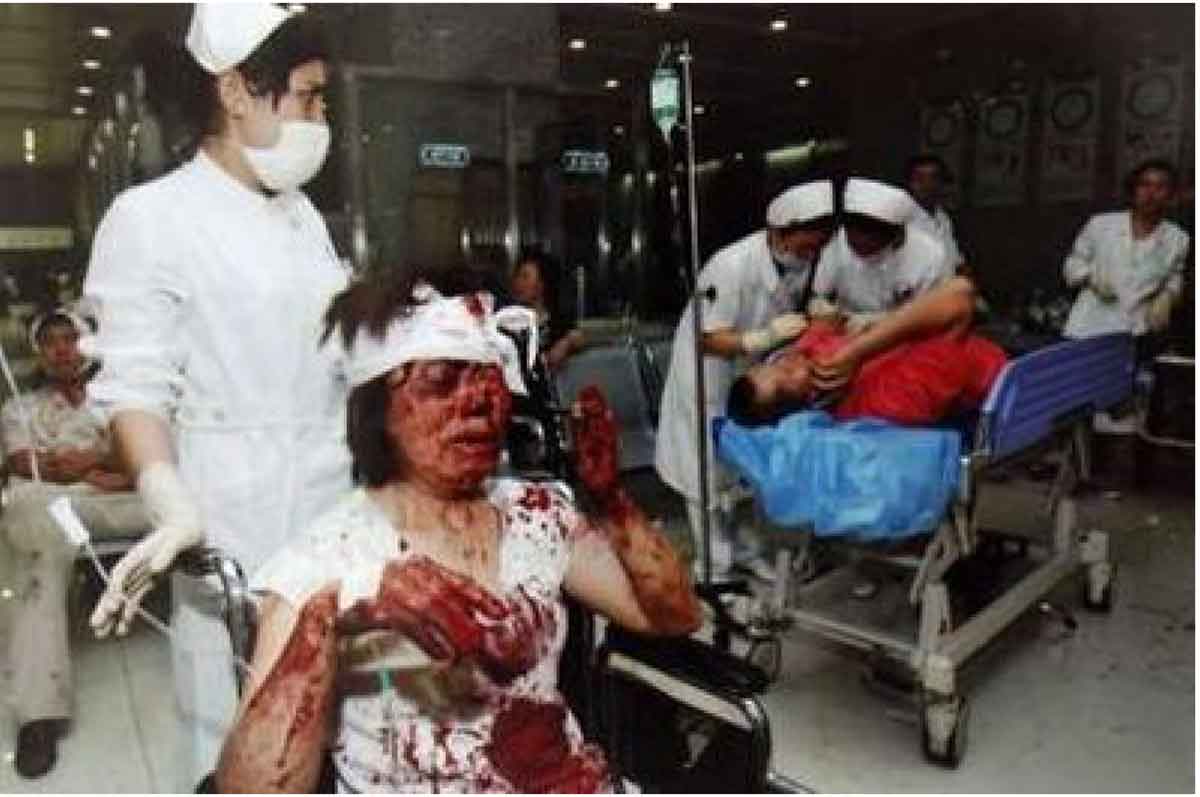
Urumqi, July 2009: Woman badly injured by racist mob incited by Uyghur anti-communist leader Rebiya Kadeer.
Firstly, although China’s ethnic minorities have gained the most from the founding of the PRC workers state in 1949, economic inequalities between the various ethnic groups have grown since the institution of pro-market reforms in 1978. The post 1978 reforms weakened central planning, meaning that those regions that are, for historical and geographic reasons, poorer have had relatively less wealth transferred to them from the richer regions than in the days of greater planning. Thus, the standard of living in poorer Western regions like the Xinjiang Uighur Autonomous Region did not develop as fast as the coastal areas. Furthermore, the greater role of the market in the post-1978 period also led to generally greater inequality even within individual regions. Ethnic Uighurs noticed the growing difference in wealth not only between the Xinjiang Uyghur Autonomous Region and wealthier provinces but also between themselves and Han and Hui residents in Xinjiang who had the advantage of personal, family or educational connections with richer parts of the country. These income differences have been cynically exploited by Kadeer and her ilk. To be sure, official preferential education and other policies favouring ethnic minorities have helped to maintain improvements in the social conditions of the Uyghur people (seen in the continued rising of life expectancy and literacy levels). So has, in more recent years, President Hu Jintao’s moves to revert back to some central planning measures to transfer resources from the richer Eastern provinces back to the poorer Western regions. However, these measures have thus far not been rolled out fast enough, in part because more right-wing elements within the Communist Party of China - such as remnants of the so-called “Shanghai faction” (which was most vociferously represented by the now disgraced, former Shanghai party secretary Chen Liangyu) and pro-market advocates – have resisted Hu’s plans.
Secondly, the post-1978 emergence of a profit-driven private sector and partial erosion of the previous Iron Rice Bowl system, under which state enterprise employees have guaranteed lifetime jobs and social benefits, has led to unemployment and job insecurity for Chinese workers. This has been exacerbated by the world economic downturn. For, although the PRC economy through its state sector has powered on through the global economic crisis like no other country in the world, the collapse of capitalist economies abroad has still hit China’s heavily private-owned export sector hard, leading to many job losses. And when people have to compete for the right to earn a living then this always fuels ethnic divisions.
Thirdly, the growth of a private sector over the last 30 years means that there are many self-employed people and economically insecure small businessmen competing in the market in areas like retail, textiles and light manufacturing. The desperate economic competition between self-employed producers fosters personal rivalries between them – inevitably growing also into ethnic rivalries.
A similar effect has come from the introduction of the “Household Responsibility” system in agriculture over the last three decades. Under this system, although the agricultural land itself remains collectively owned, farmers no longer work the land together or share its produce. As a result the solidarity between farmers is not what it used to be in the days of the collectives. Furthermore, the millions of former farmers and their children who have migrated to the cities to join the industrial workforce enter factories without the strong collectivist traditions that long-time state enterprise employees enjoy. This was, no doubt, a factor in the June 26 brawl at the toy factory in Shaoguan city.
To address each of these problems requires the strengthening of the socialistic, public sector of the Chinese economy as opposed to the private sector. The mass layoffs by private enterprises during the global downturn have proven that this profit-driven sector cannot be relied on to guarantee jobs for workers. Although the Communist Party government’s measures have boosted hiring by state firms to partly compensate for private sector job losses, it is imperative for the sake of employment that the labour-intensive light manufacturing sector be brought back under state ownership. This can be commenced through the state taking over the more viable of closed down private firms, consolidating them into larger operations and reopening them as state-owned enterprises. Furthermore, private bosses that violate China’s new pro-worker Labour Law by illegally laying off employees should be severely punished by having their firms immediately nationalized without compensation. Meanwhile, the state-owned enterprises should themselves be more geared to boosting employment and the famous Iron Rice Bowl system for employees of state firms should be gradually rebuilt. In general, the state-owned enterprises need to be subject to greater overall planning to meet key social goals rather than be left to operate under “market principles.” This will ensure that the state enterprises not only put employment high up in the list of their priorities but also devote more energy to developing the poorer Western regions of China and commit to special hiring of economically disadvantaged ethnic minorities like the Uyghurs.
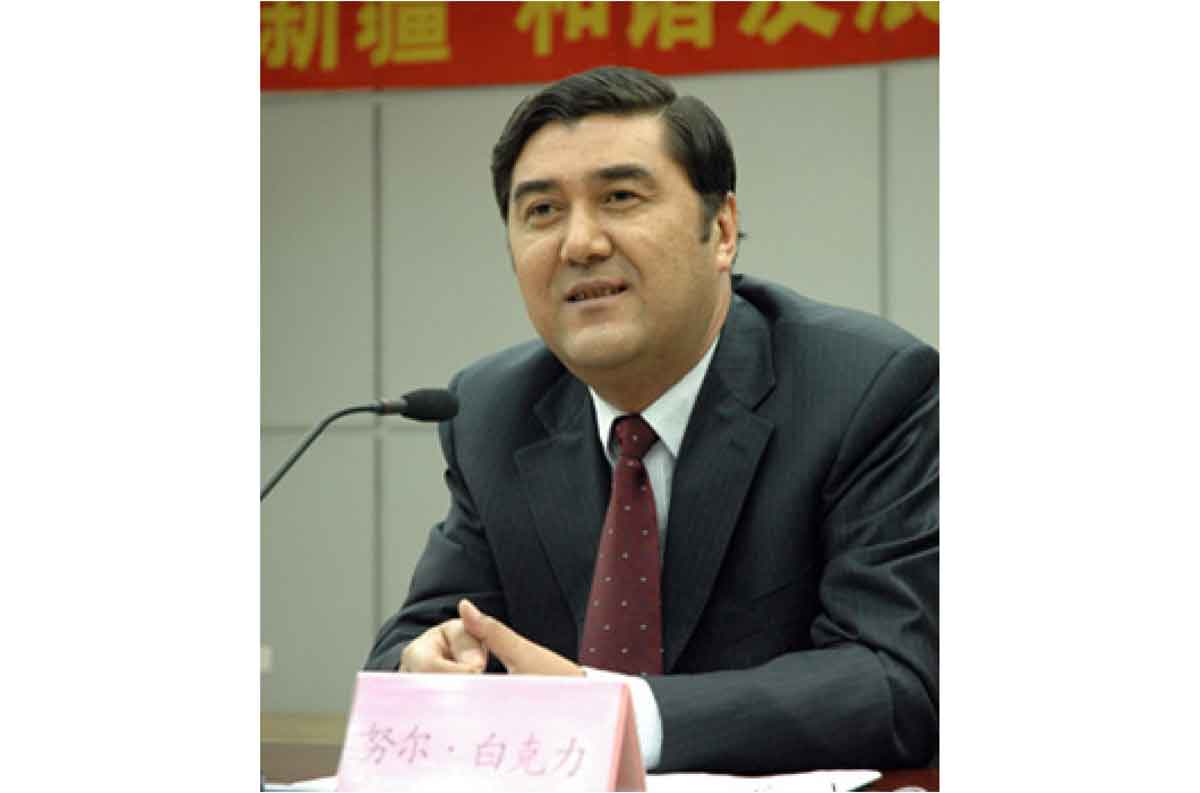
Nur Bekri, an ethnic Uyghur who is head (Chairman) of the PRC ‘s, Xinjiang Uyghur Autonomous Region government. Australian media hid from the public that many such pro-communist, pro-PRC Uyghur leaders exist. Western media only deems right-wing, anti-PRC Uyghur figures like Rebiya Kadeer to be worthy of the title, “Uyghur leader.”
The cutthroat competition between struggling self-employed people - competition that fuels ethnic rivalries - should be relieved through the formation of cooperatives. The PRC governments should encourage the formation of such producer cooperatives by providing incentives for individuals to join into such cooperatives – such as promises of free equipment, transport vans/trucks and cheap credit. These cooperatives can then grow into larger collectives – collectives that will unite within them peoples of all ethnicities. A similar process of voluntary recollectivisation should be fostered amongst farmers. Meanwhile, premier Wen Jiabao’s plan to replace the collective operation of forests with a “Housheold Responsibility” system, similar to that which was introduced in agriculture, should be scrapped.
Don’t Listen to What Confucius Says!
And Don’t Seek Common Ground with The Kuomintang!
To further develop inter-ethnic relations in China is not only a matter of directly addressing economic issues. Ideological and social factors are also important. Consider some of the changes in these areas that have happened in recent decades. With the emergence of a small capitalist class in China in the post-1978 period, Beijing has more and more embraced Chinese nationalism as an ideology to hold the different classes together. Reverence for pre-1949 Han Chinese traditions and Confucianism are being slowly revived. Some of this is happening in very subtle ways. From 2008, the former Golden Week public holiday during May Day – the international workers day – was reduced to a one-day holiday and instead national holidays celebrating old Chinese traditions - Tomb-Sweeping Day, Dragon-boat Festival and Mid Autumn Festival – were introduced. Although the move was motivated as a technical measure to reduce public transport overcrowding during Golden Week holidays, the ideological dimension of the change is also apparent. In part, such moves are motivated by a wish – a rather unrealistic one – to appease the rulers of the imperialist powers by presenting the PRC in a way that is less offensive to these capitalists. The outside image of the PRC was to be not that of a socialistic state founded through an anti-capitalist revolution but as a “Confucian” country seeking to live in harmony with the outside world and based, not on class struggle, but on Chinese cultural traditions. The push to present this new image accelerated in the lead up to the 2008 Beijing Olympics as the conciliatory Chinese government hoped that an appeasing image of the PRC would pacify the Western push to disrupt the Games. Sadly, at the Olympics opening ceremony itself, the historical part of the performance was weighted so as to emphasise more the pre-1949 history and Confucius than the 1949 revolution, Mao and the Peoples Republic.
Now to embrace the rich positive aspects of Chinese history – music, invention, arts, dress, etc – is good. However, when the overall pre-1949 societies are simultaneously portrayed in a positive light then this is offensive to China’s ethnic minorities because in these pre-1949 regimes the minority peoples were brutally oppressed, not to mention the mass of Chinese peasants, workers and women.
A problem arises not simply when the pre-1949 political order is in any way lauded but even when its ideological/philosophical underpinnings are prettified. For when this happens, one starts to glorify some pretty reactionary trends. In particular, when Confucianism is commended, what is being praised is an ideology that preaches that women are subordinate to men. Confucian thought was a big portion of the ideological basis for the compulsory marriage of all girls according to their parents’ wishes in pre-1949 times. The Confucian system of ancestor worship only by males (and that only of male ancestors) encouraged the terrible practice in pre-1949 China of girl children often being murdered by their parents because they could not perform the duties of ancestor worship. It is for all these reasons that the Communist Party of China, quite rightly, fought against Confucianism in the first decades after it took power. Although today it is not the most reactionary aspects of Confucianism that are being praised but more benign ones like benevolence, any revival in this ideology which is based on ritualized hierarchical relations is a bad thing. It is an obstacle to building an egalitarian society where the toiling classes rule and women are liberated. Furthermore, the partial rehabilitation of Confucianism is particularly hurtful to the feelings of many ethnic minority peoples. For it was Confucian ideology that tried to make their ancestors deferentially kowtow to the Han and Manchu officials of the feudal/capitalist governments that oppressed them in pre-1949 times.
Similar suspicions amongst minority peoples will now be created by some of the hype that has surrounded the PRC’s improved relations with capitalist Taiwan. Although it is quite permissible for workers states to, for tactical advantage, seek better diplomatic ties with one or another capitalist country, this should never involve any blurring of the political line that separates the workers state from the capitalist state in question. Unfortunately, however, Beijing has accompanied its improved relations with Taiwan with attempts to find common ground with Taiwan’s Kuomintang rulers on the basis of common Han Chinese heritage and even on the basis of some shared political ground - like mutual respect for Sun Yat-Sen. However, stressing a shared Chinese cultural heritage with Taiwan’s capitalist rulers may not only leave the PRC’s non-Han ethnic groups feeling a bit excluded but can breed cynicism amongst some in these minority communities who would think that they are being asked to remain part of the PRC for the sake of socialism, yet the PRC is embracing Taiwanese rulers who are capitalist simply because they are Han Chinese.
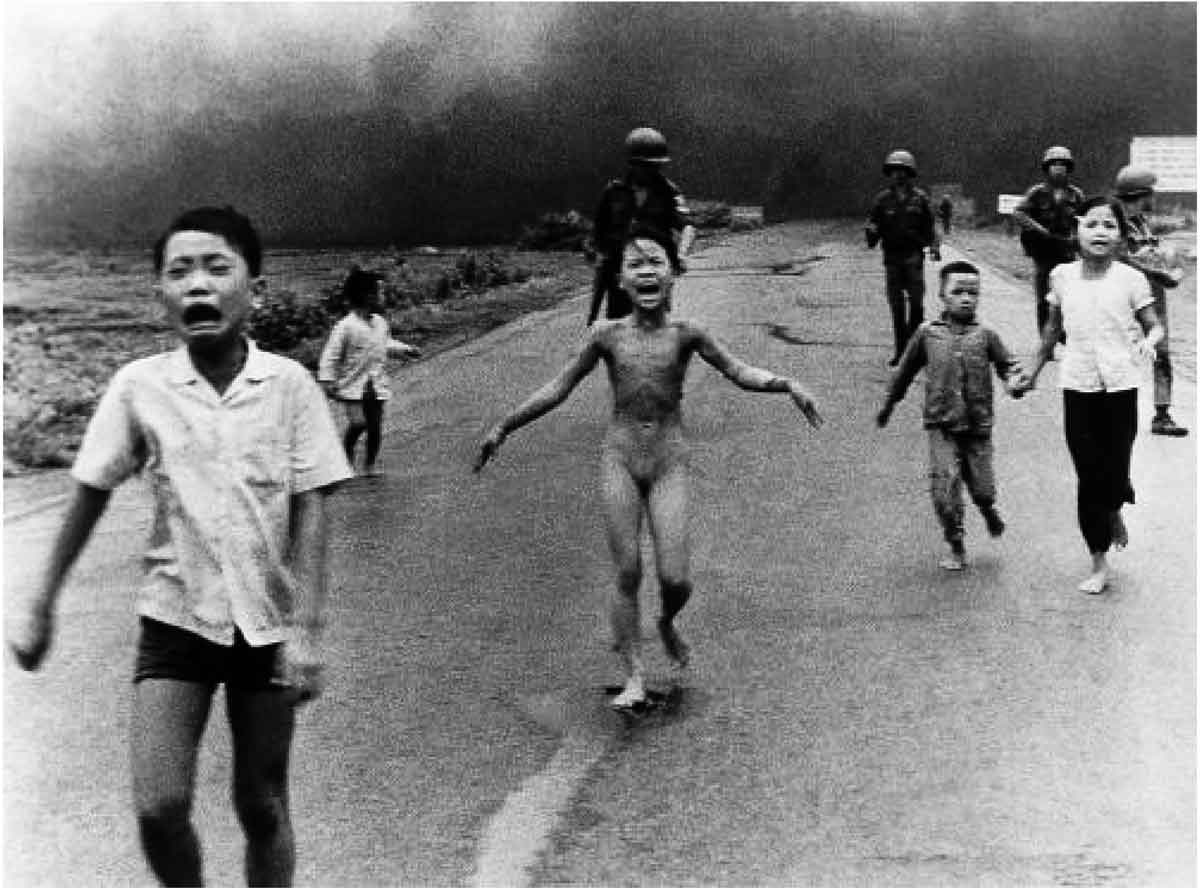
Vietnam, 1972: A girl hit by a U.S. napalm attack forced to tear off her burning clothes. As once again shown in Urumqi, imperialists and the anti-communist outfits that they back will use the most terrifying methods to attack pro-communist states and leftist liberation movements.
Furthermore, any attempt at all to find common political ground with the Kuomintang, who after all are the brutal capitalist/landlord party that was overthrown in the 1949 Revolution, is insulting to the PRC’s ethnic minorities. Just think how the Uyghur and Kazakh peoples of Xinjiang would feel about any tempering of opposition to the Kuomintang. During Kuomintang-ruled China, the Han governor of Xinjiang from 1928-1933, Jin Shuren, terribly discriminated against non-Han peoples. He incited ethnic conflicts by confiscating land from the Kazakhs and Uyghur peoples on the promise of giving it to Han Chinese (actually he only gave it to his cronies). His successor, warlord Sheng Shicai, was also a brutal Han chauvinist who used torture against Kazakh and Uyghurs (and also killed Han communists like Mao Tse Tung’s brother Mao Zemin). The Kazakhs in Xinjiang were quite justified in both rebelling against this racist capitalist/feudal regime and in seceding from it to establish a pro-Soviet East Turkestan Republic from 1944 to 1949 (which allied itself with the People’s Liberation Army).
The glue that holds the different ethnic groups of China together is not the pre-1949 traditions and less still the philosophies and Chinese regimes of those times but common solidarity with the struggle to found and build the socialistic PRC. It is this struggle that began the liberation of the toilers of all ethnicities. And it is this struggle that started the march towards freedom from discrimination for the minority communities. So let us celebrate not Confucius or any “common” heritage with the Kuomintang but let us instead proudly and grandly celebrate the 60th Anniversary of the Chinese Revolution that occurred on October 1!
Where Will The Truth Come From?
Notwithstanding their feigned concern for China’s ethnic minorities, if the Western media’s drive to destroy the PRC workers state was successful it would lead once again to the subjugation of minority peoples. For a new capitalist regime will inevitably be Han-chauvinist – just like Chiang Kai-Shek’s Kuomintang.
Regrettably, in Australia it is not only the capitalist media that is seeking to undermine the PRC. Even some socialist groups echo the mainstream media’s anti-PRC propaganda. In a shocking piece of journalism for a bona fide left-wing newspaper, the Socialist Alliance group’s Green Left Weekly ran an article in its July 11 issue that was titled “East Turkestan: Chinese Oppression Behind Riots.” The article, which would have fitted well in any Rupert Murdoch publication, began with a sentence echoing the U.S. government-funded World Uyghur Congress’ lies about the events: “On July 5, hundreds were killed in the East Turkestan capital, Urumqi, after protests by Uyghurs against racism and discrimination were attacked by Chinese security forces.” The article then gets no better - at one point even spreading the utter falsehood that, “the Uyghur language is being phased out of the education system” in Xinjiang! Fortunately, not every political organization in Australia has fallen in behind the anti-communist, anti-PRC crusade. The Communist Party of Australia, for example, has sometimes written articles effectively exposing anti-PRC propaganda. And we in Trotskyist Platform (TP) have not only opposed the anti-communist, anti-PRC drive in our journals but have actively campaigned in solidarity with the PRC workers state. Following the anti-PRC mobilizations in the West that followed the March 2008 riots in the Tibetan Autonomous Region, TP widely distributed here a pro-PRC Open Letter of Solidarity with Consular Staff of The Peoples Republic of China And with China’s Masses.
It is the duty of all who call themselves socialists in Australia to expose the anti-socialist media propaganda against the PRC. Such work by local communists will be a factor in how the anti-PRC campaigns will ultimately be defeated. The efforts of pro-PRC, Chinese international students in spreading awareness of Red China’s achievements are also crucial. The magnificent mobilisation of pro-PRC students to defend the April 2008 Olympic torch relay in Canberra certainly had an impact. For one it smashed the myth that the entire Chinese population is an imprisoned mass craving for the West to “free” them from “communist tyranny.” When, during the torch relay, ignorant white anti-communist demonstrators yelled out “Free China!”, pro-PRC Chinese students responded powerfully by shouting back: “We are free back in China! What are you talking about?”
However, the mass of Australian working class people will only start to see the dishonesty of the mainstream media’s portrayal of the PRC when they connect it with the media’s similar hostility to workers organisations and struggles at home. When they notice that the Murdoch papers that condemn the PRC’s attempts to stop pro-capitalist forces are the very same newspapers that go hysterical when CFMEU construction union officers enter building sites to challenge greedy capitalist bosses. Australian trade unionists will dismiss anti-PRC propaganda when they understand that enmity to the organisation of Chinese masses to rule in a socialistic state is just an extreme form of the media’s hostility to workers here who organise to fight for their rights through industry-wide union campaigns (or “pattern bargaining”). When they understand that anti-PRC media rants reflect the capitalist owners of the media’s own class prejudice – prejudice that makes these tycoons hostile to societies like the PRC and Cuba that are ruled by the toiling classes just as it makes them continuously want to slander the poor and unemployed in Australia as unworthy people deserving of their fate.
It is to help the Australian working class realize this connection between the capitalist attacks that they face at home and the attacks on the PRC that Trotskyist Platform devotes much patient work to. We seek to build a strong bond between the Australian working class and the PRC workers state. This partnership should not be an alliance of convenience but true unity based on identical interests and working class solidarity. The Australian working class must be won to seeing the PRC as their state because, despite its many conciliations to the capitalist enemy, the PRC is still a form of working-class peoples state. Similarly, we hope that those of the students who participated in the pro-PRC, Canberra torch relay demonstration not mainly because they are Chinese but because they are pro-socialist will see the Australian masses struggle as their struggle. And we hope that these Chinese students will actively support the class struggles of the Australian toiling classes.
When the exploited classes in the West see pro-communist supporters of the PRC joining their struggles it will help them to see that the PRC is indeed (in however a deformed way) a workers state. When the Western working classes then start to support the PRC workers state they will pull themselves closer to understanding the need for themselves to also take state power in their own countries. When the oppressed masses in the West take state power by deposing their capitalist exploiters then the PRC will finally be safe from counterrevolutionary attacks. And all the internal obstacles to China’s march to socialism will gradually fall off - like cockroaches denied a food source.
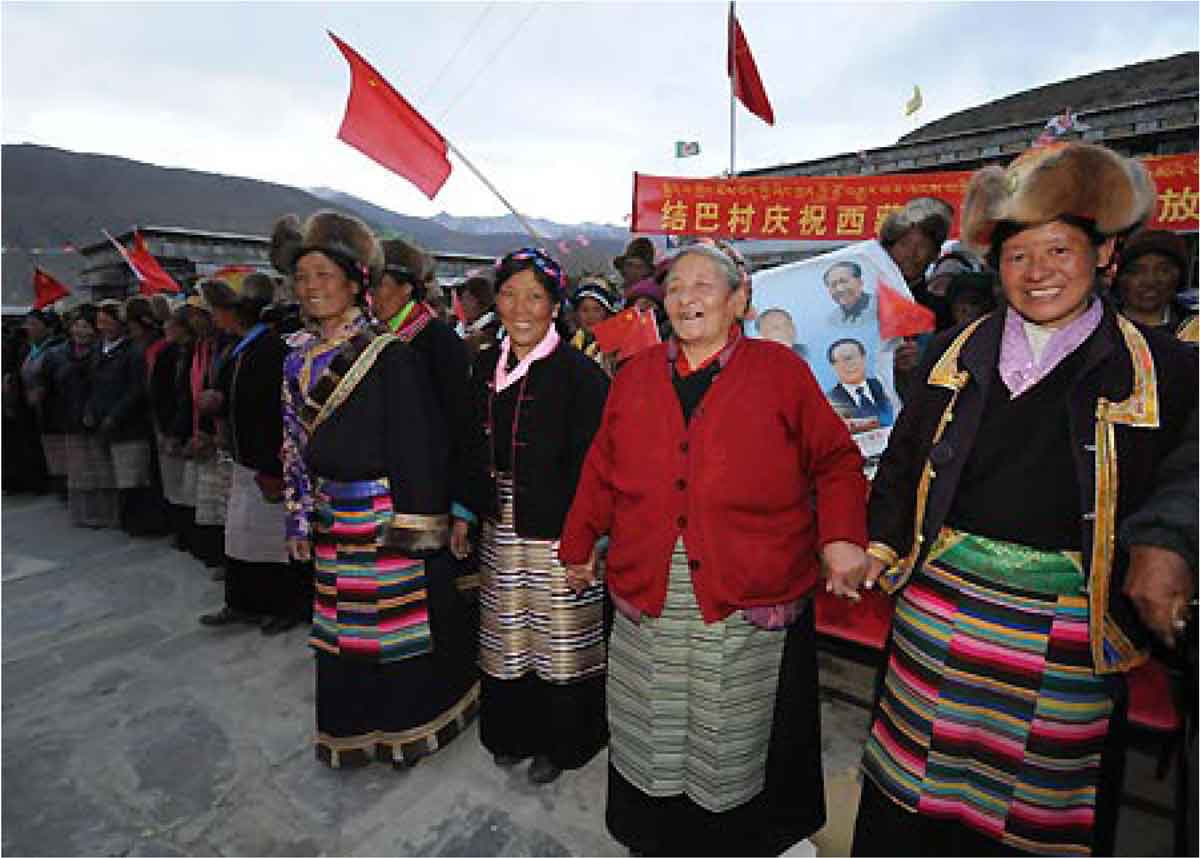
March 2009, Tibet Autonomous Region of the PRC: Ethnic Tibetans at Jiaba Village hold a celebration in the lead up to the March 28 Serfs Emancipation Day. Serfs Emancipation Day marked the 50th anniversary of the liberation of serfs and slaves in Tibet following the overthrow of the feudal Dalai Lama-led monarchy by pro-communist forces. Serfs Emancipation Day was passionately celebrated by former slaves, serfs and their descendants.
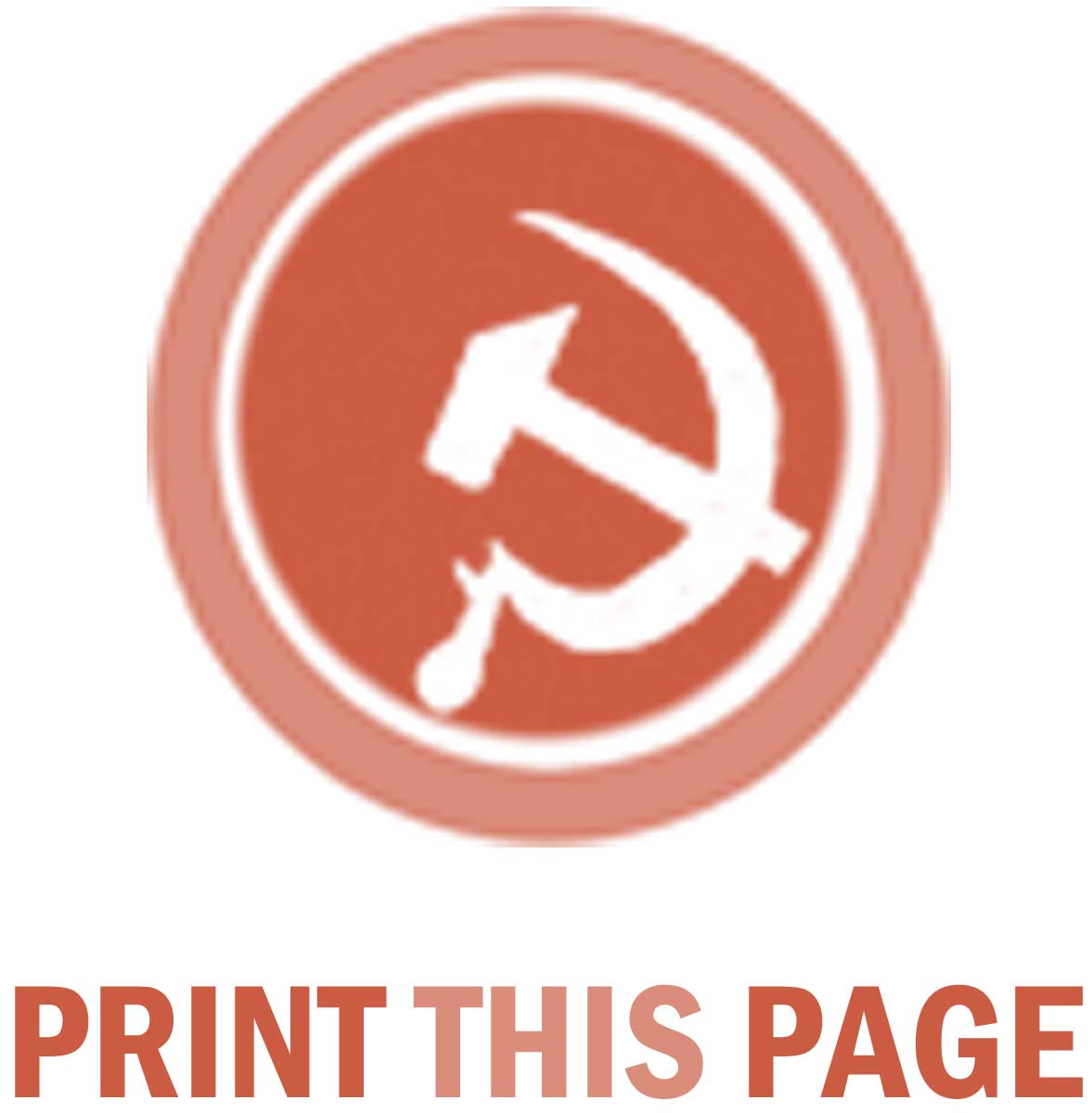
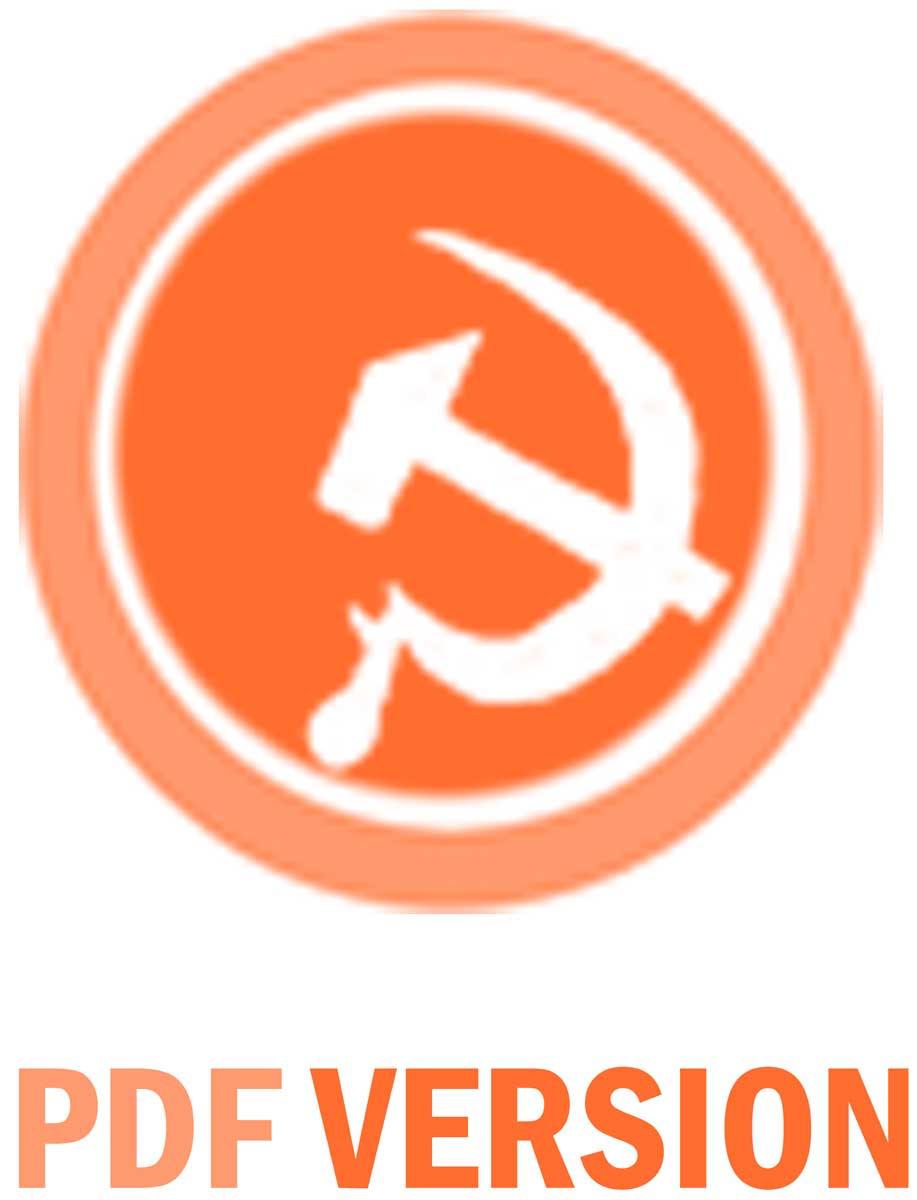
Trotskyist Platform: PO Box 1101, Fairfield NSW 1860, Australia.
E-mail: trotskyistplatform@gmail.com
Phone (Australia): 0417 204 611
Phone (International):0061 417 204 611
